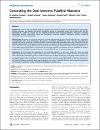Connecting the dots between PubMed abstracts
| Author | Hossain, M. Shahriar |
| Author | Gresock, Joseph |
| Author | Edmonds, Yvette |
| Author | Helm, Richard |
| Author | Potts, Malcom |
| Author | Ramakrishnan, Naren |
| Available date | 2016-03-31T14:00:59Z |
| Publication Date | 2012-01 |
| Publication Name | PLoS ONE |
| Resource | Scopus |
| Citation | Hossain MS, Gresock J, Edmonds Y, Helm R, Potts M, Ramakrishnan N (2012) Connecting the Dots between PubMed Abstracts. PLoS ONE 7(1): e29509. |
| ISSN | 1932-6203 |
| Abstract | Background: There are now a multitude of articles published in a diversity of journals providing information about genes, proteins, pathways, and diseases. Each article investigates subsets of a biological process, but to gain insight into the functioning of a system as a whole, we must integrate information from multiple publications. Particularly, unraveling relationships between extra-cellular inputs and downstream molecular response mechanisms requires integrating conclusions from diverse publications. Methodology: We present an automated approach to biological knowledge discovery from PubMed abstracts, suitable for "connecting the dots" across the literature. We describe a storytelling algorithm that, given a start and end publication, typically with little or no overlap in content, identifies a chain of intermediate publications from one to the other, such that neighboring publications have significant content similarity. The quality of discovered stories is measured using local criteria such as the size of supporting neighborhoods for each link and the strength of individual links connecting publications, as well as global metrics of dispersion. To ensure that the story stays coherent as it meanders from one publication to another, we demonstrate the design of novel coherence and overlap filters for use as post-processing steps. Conclusions: We demonstrate the application of our storytelling algorithm to three case studies: i) a many-one study exploring relationships between multiple cellular inputs and a molecule responsible for cell-fate decisions, ii) a many-many study exploring the relationships between multiple cytokines and multiple downstream transcription factors, and iii) a one-to-one study to showcase the ability to recover a cancer related association, viz. the Warburg effect, from past literature. The storytelling pipeline helps narrow down a scientist's focus from several hundreds of thousands of relevant documents to only around a hundred stories. We argue that our approach can serve as a valuable discovery aid for hypothesis generation and connection exploration in large unstructured biological knowledge bases. |
| Sponsor | Institute for Critical Technology and Applied Science, Virginia Tech, and the US National Science Foundation through grant CCF-0937133. |
| Language | en |
| Publisher | Public Library of Science |
| Subject | Cytokines Glutamine Pyruvate Transcription factors Brain damage Inflammation Mouse models Polymerases |
| Type | Article |
| Issue Number | 1 |
| Volume Number | 7 |
Files in this item
This item appears in the following Collection(s)
-
Biological & Environmental Sciences [791 items ]


